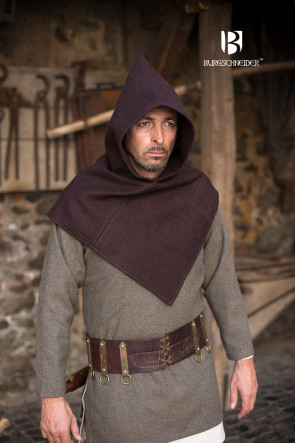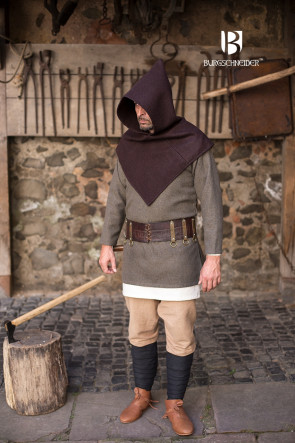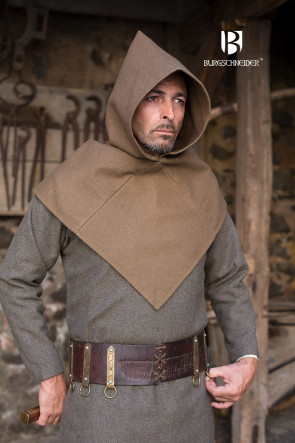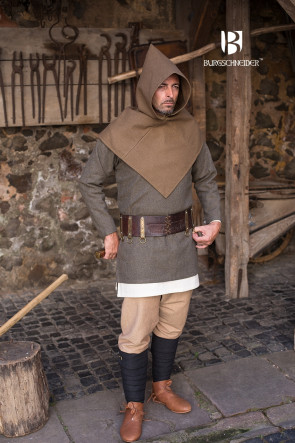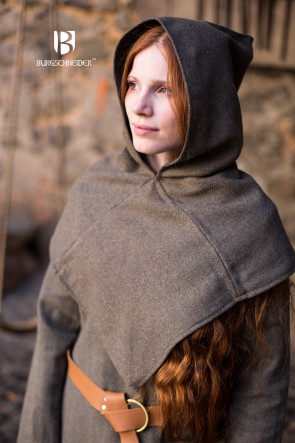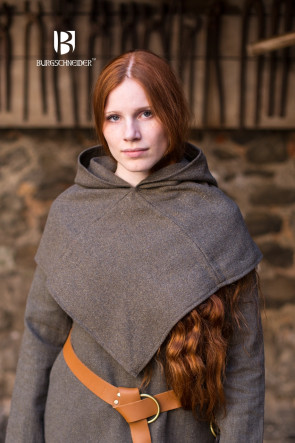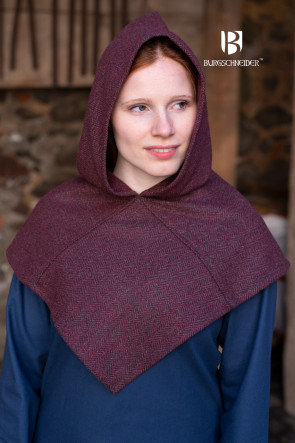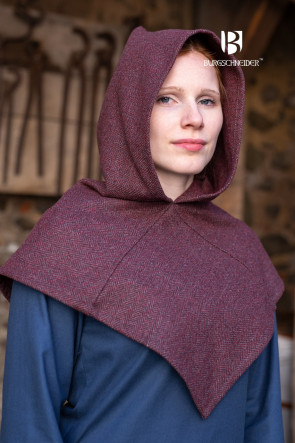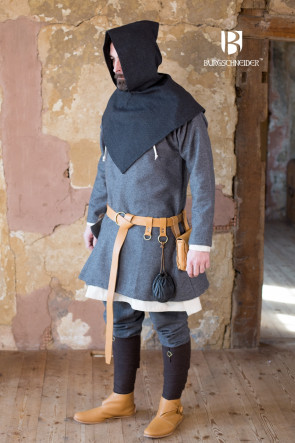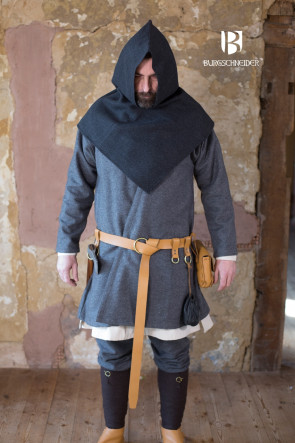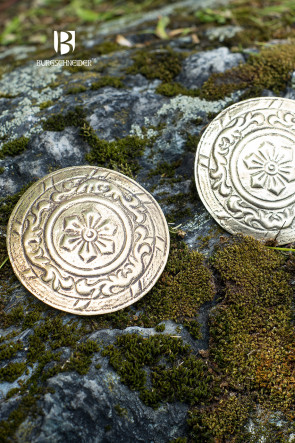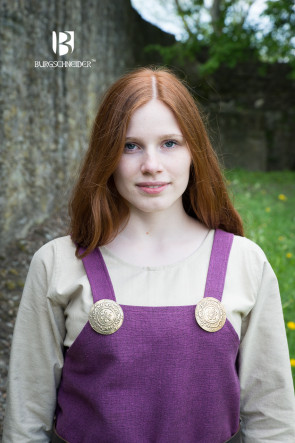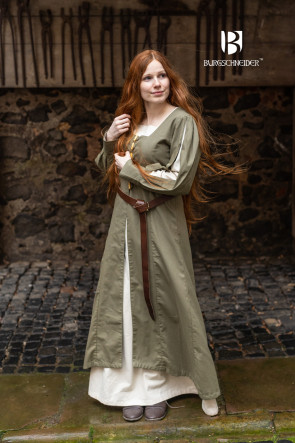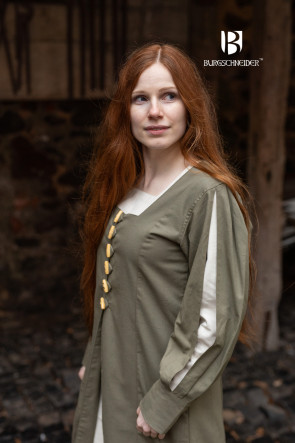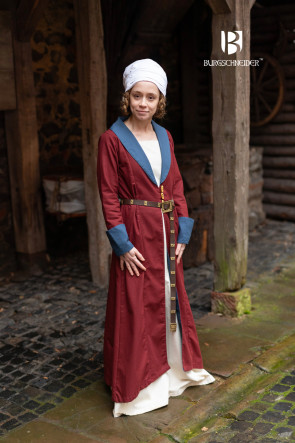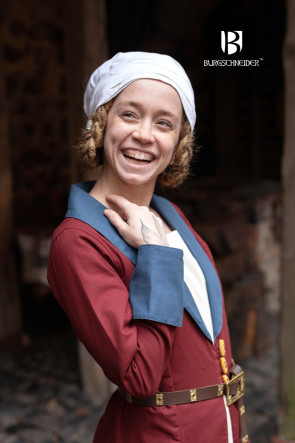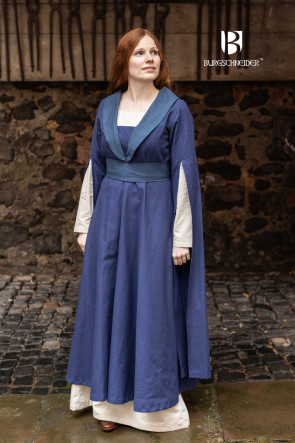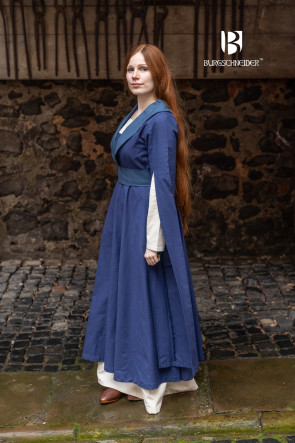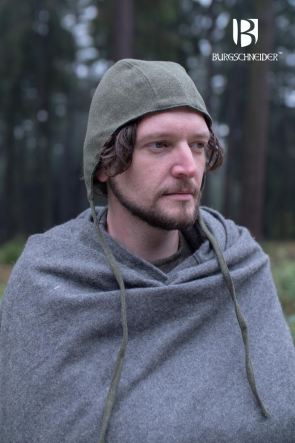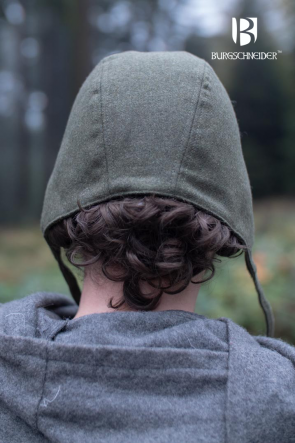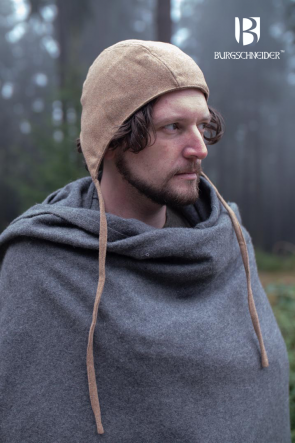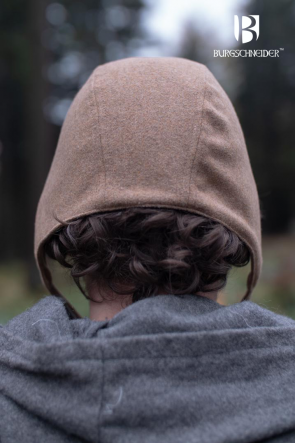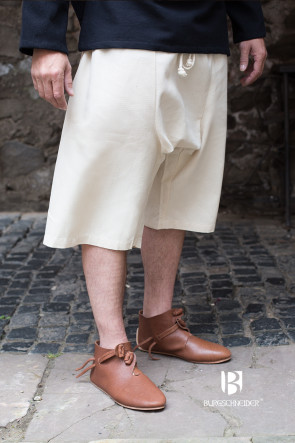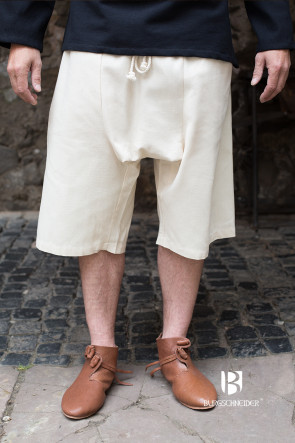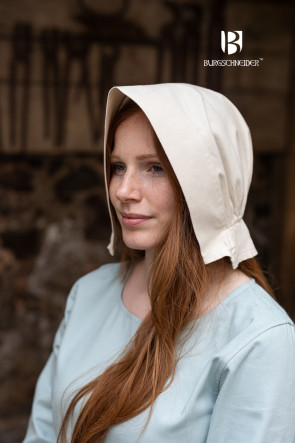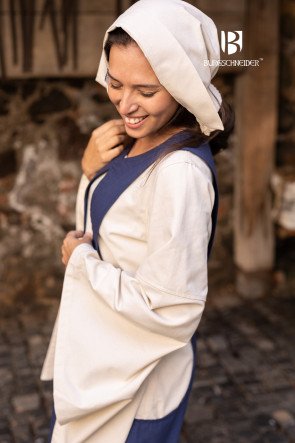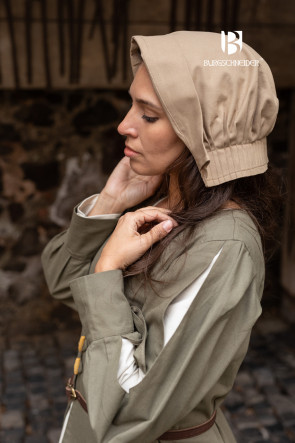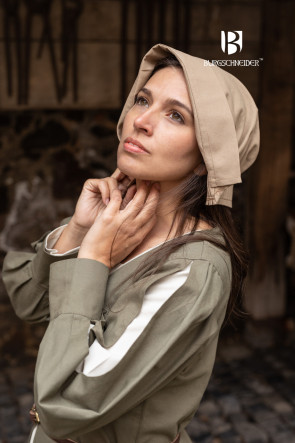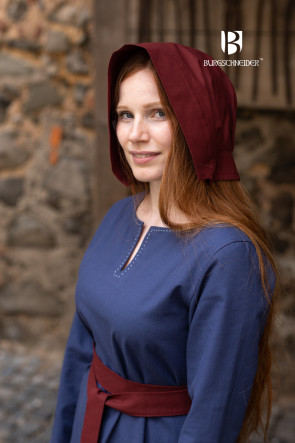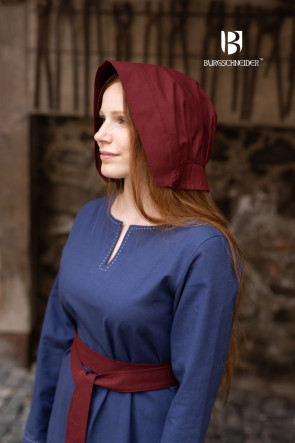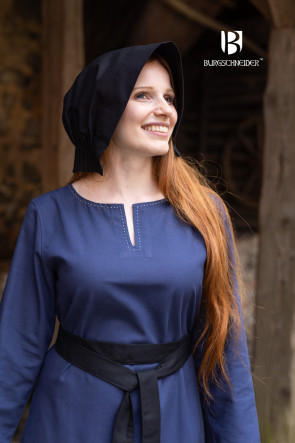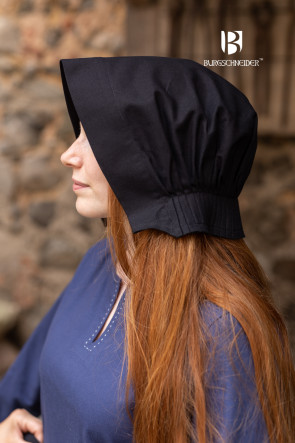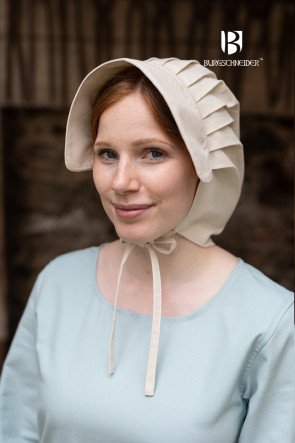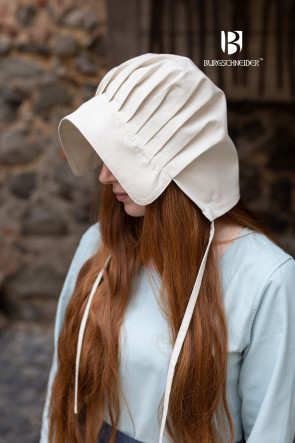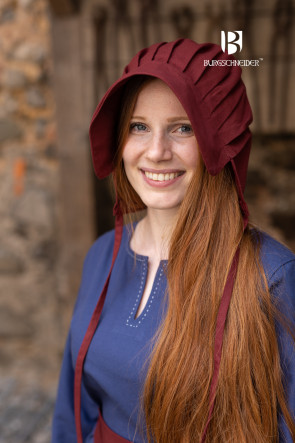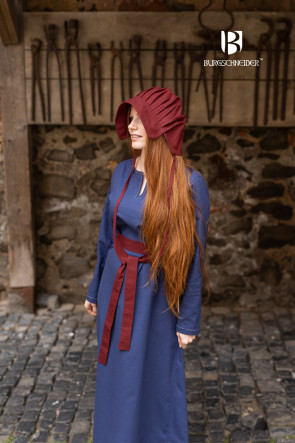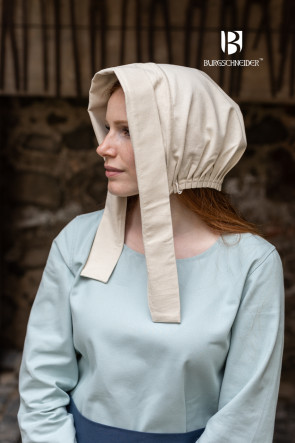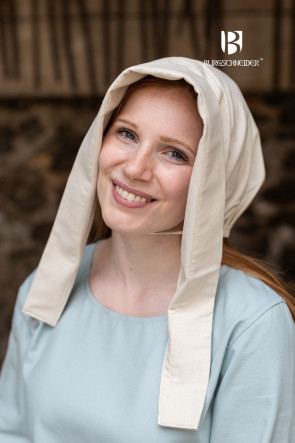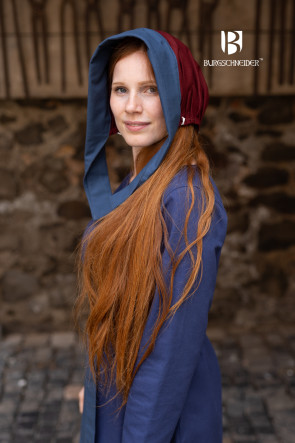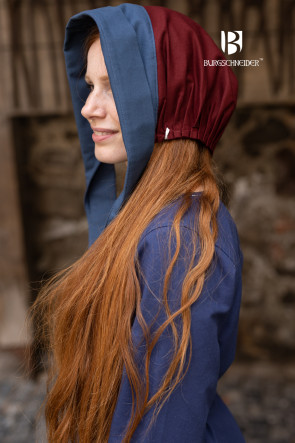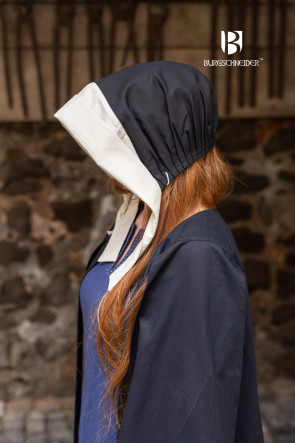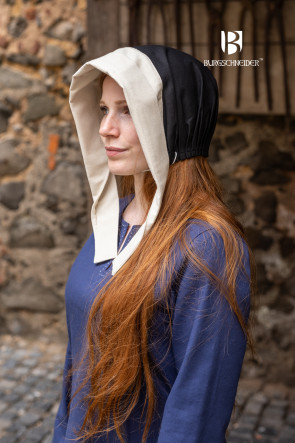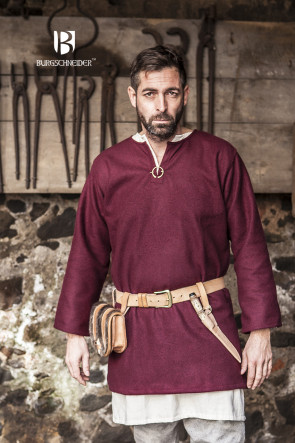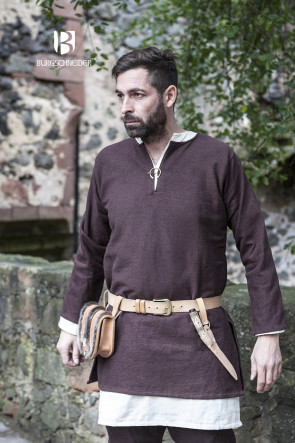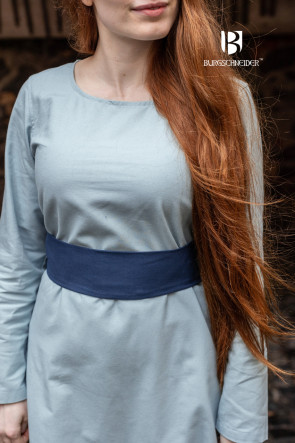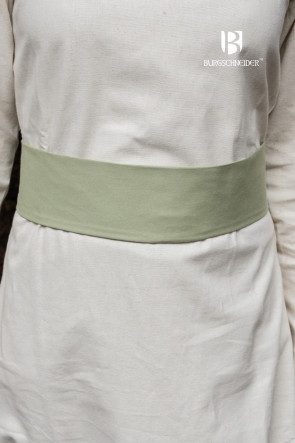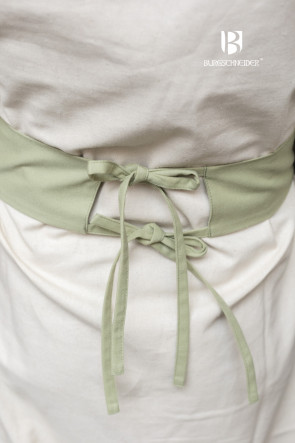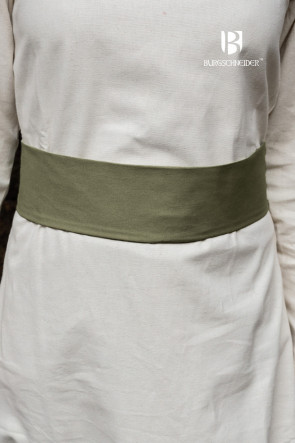High Middle Ages ca. 1100-1300
The High Middle Ages usually designate the time from the 11th to the 13th centuries. Most notably, compared to the Early Middle Ages, during the the High Middle Ages the garments of the nobility had become far more conspicuous, more colorful, and form-fitting.
According to contemporary research, the most common clothing item was the “cote,” a rather simple garment worn by rich and poor, men and women alike. However, the cote’s shape and color varied, depending upon the wearer’s gender and stratum.
The garments of the poor in the High Middle Ages
The simple shape of the cote was quite popular with the lower strata and it was frequently worn by the poor. So, for instance, the Landsässische Tracht (garb worn by Landsassen; Middle High German for ’farm workers’), usually consisted of an undershirt and breeches (a kind of medieval briefs) as undergarments under a belted cote and chauces, usually with a coif (‘Bundhaube’) as headwear, topped off with a hat or a hood. Farmers and simple peasants usually wore clothes made from wool or linen, as these materials were easy to produce and inexpensive to obtain.
Clothing of the nobility in the High Middle Ages
Because clothing in the High Middle Ages was also considered a symbol of status and the nobility fancied showing off their prosperity, obtaining the most exquisite fabrics quickly became quite a sumptuous affair. Although the pattern of the cote worn by the nobility resembled that of the peasants, the garment was hardly suitable for practical labor. Noble men usually wore cotes with varying lengths (from the middle of the thighs to the middle of the calves), while women’s dresses were often long enough to draggle on the floor. Additionally the rich attempted to use (and thus show off) as much fabric as possible and therefore pleated it vertically. As a result, the motif of the pleated garment was quite popular in the visual arts of that time.
Dyed fabrics were, due to the rarity of dyes, quite expensive, which is why the colorful garb of the nobility stood out from the untreated farbics worn by the lower strata.
-
Skjoldehamn Wool Cowl Bjorn - Brown
The Skjoldehamn Cowl was discovered in a pagan grave from the first half of the 11th century. This is one of the first examples of the headgear "Gugel" itself.
The hood has a basic square shape, characteristically the wide brim ends with a corner on the chest.
The grave find from Skjoldehamn raised many questions since its recovery in 1936 and still occupies today. According to current research, the dating of the pagan grave in the marshland is the first half of the 11th century. The hood of the gugel from Skjoldehamn has a simple square basic shape and a very wide brim, which does not fall round, but with a corner on the chest. This gugel is also a very early example of the type of headgear that became a ubiquitous garment in Europe during the Middle Ages.
In the course of research, attempts were made to assign the garment to a gender and cultural group. For this purpose, not only the DNA of the buried person was examined more closely, but also the additional finds. The enclosed trousers determined the theory of the researchers that the person must have been male. DNA examination in 1999 showed no Y chromosome present in the bones, which supported the theory that it had to be a woman instead. However, this methodology is considered outdated.
The question of culture points to Norway. This is assumed by ornamentation and morphological features, which suggest that the buried person was a Sami tribal member. Further research is needed, as some key evidence for these hypotheses is still lacking. More modern DNA analysis and research into the history of the fashions of the various Sami groups will shed light on this.
Learn More€25.13 -
Skjoldehamn Wool Cowl Bjorn - Autumn Green
The Skjoldehamn Cowl was discovered in a pagan grave from the first half of the 11th century. This is one of the first examples of the headgear "Gugel" itself.
The hood has a basic square shape, characteristically the wide brim ends with a corner on the chest.
The grave find from Skjoldehamn raised many questions since its recovery in 1936 and still occupies today. According to current research, the dating of the pagan grave in the marshland is the first half of the 11th century. The hood of the gugel from Skjoldehamn has a simple square basic shape and a very wide brim, which does not fall round, but with a corner on the chest. This gugel is also a very early example of the type of headgear that became a ubiquitous garment in Europe during the Middle Ages.
In the course of research, attempts were made to assign the garment to a gender and cultural group. For this purpose, not only the DNA of the buried person was examined more closely, but also the additional finds. The enclosed trousers determined the theory of the researchers that the person must have been male. DNA examination in 1999 showed no Y chromosome present in the bones, which supported the theory that it had to be a woman instead. However, this methodology is considered outdated.
The question of culture points to Norway. This is assumed by ornamentation and morphological features, which suggest that the buried person was a Sami tribal member. Further research is needed, as some key evidence for these hypotheses is still lacking. More modern DNA analysis and research into the history of the fashions of the various Sami groups will shed light on this.
Learn More€25.13 -
Skjoldehamn Gugel Knud Herringbone - Olive/Grey
The Skjoldehamn Cowl was discovered in a pagan grave from the first half of the 11th century. This is one of the first examples of the headgear "Gugel" itself.
Learn More
The hood has a basic square shape, characteristically the wide brim ends with a corner on the chest.
The grave find from Skjoldehamn raised many questions since its recovery in 1936 and still occupies today. According to current research, the dating of the pagan grave in the marshland is the first half of the 11th century. The hood of the gugel from Skjoldehamn has a simple square basic shape and a very wide brim which does not fall round but with a corner on the chest. This gugel is also a very early example of the type of headgear that became a ubiquitous garment in Europe during the Middle Ages.
In the course of research, attempts were made to assign the garment to a gender and cultural group. For this purpose, not only the DNA of the buried person was examined more closely but also the additional finds. The enclosed trousers determined the theory of the researchers that the person must have been male. DNA examination in 1999 showed no Y chromosome present in the bones which supported the theory that it had to be a woman instead. However, this methodology is considered outdated.
The question of culture points to Norway. This is assumed by ornamentation and morphological features which suggest that the buried person was a Sami tribal member. Further research is needed, as some key evidence for these hypotheses is still lacking. More modern DNA analysis and research into the history of the fashions of the various Sami groups will shed light on this.€34.90 -
Skjoldehamn Gugel Knud Herringbone - Burgundy/Grey
The Skjoldehamn Cowl was discovered in a pagan grave from the first half of the 11th century. This is one of the first examples of the headgear "Gugel" itself.
Learn More
The hood has a basic square shape, characteristically the wide brim ends with a corner on the chest.
The grave find from Skjoldehamn raised many questions since its recovery in 1936 and still occupies today. According to current research, the dating of the pagan grave in the marshland is the first half of the 11th century. The hood of the gugel from Skjoldehamn has a simple square basic shape and a very wide brim which does not fall round but with a corner on the chest. This gugel is also a very early example of the type of headgear that became a ubiquitous garment in Europe during the Middle Ages.
In the course of research, attempts were made to assign the garment to a gender and cultural group. For this purpose, not only the DNA of the buried person was examined more closely but also the additional finds. The enclosed trousers determined the theory of the researchers that the person must have been male. DNA examination in 1999 showed no Y chromosome present in the bones which supported the theory that it had to be a woman instead. However, this methodology is considered outdated.
The question of culture points to Norway. This is assumed by ornamentation and morphological features which suggest that the buried person was a Sami tribal member. Further research is needed, as some key evidence for these hypotheses is still lacking. More modern DNA analysis and research into the history of the fashions of the various Sami groups will shed light on this.€34.90 -
Skjoldehamn Gugel Knud Herringbone - Black/Grey
The Skjoldehamn Cowl was discovered in a pagan grave from the first half of the 11th century. This is one of the first examples of the headgear "Gugel" itself.
Learn More
The hood has a basic square shape, characteristically the wide brim ends with a corner on the chest.
The grave find from Skjoldehamn raised many questions since its recovery in 1936 and still occupies today. According to current research, the dating of the pagan grave in the marshland is the first half of the 11th century. The hood of the gugel from Skjoldehamn has a simple square basic shape and a very wide brim which does not fall round but with a corner on the chest. This gugel is also a very early example of the type of headgear that became a ubiquitous garment in Europe during the Middle Ages.
In the course of research, attempts were made to assign the garment to a gender and cultural group. For this purpose, not only the DNA of the buried person was examined more closely but also the additional finds. The enclosed trousers determined the theory of the researchers that the person must have been male. DNA examination in 1999 showed no Y chromosome present in the bones which supported the theory that it had to be a woman instead. However, this methodology is considered outdated.
The question of culture points to Norway. This is assumed by ornamentation and morphological features which suggest that the buried person was a Sami tribal member. Further research is needed, as some key evidence for these hypotheses is still lacking. More modern DNA analysis and research into the history of the fashions of the various Sami groups will shed light on this.€34.90 -
Round Brooches Set Ingwaz
Our two-piece round brooch set Ingwaz is handmade and can be used in many ways, e.g. individually, depending on the purpose. At the back is a clasp, similar to a safety pin. Each brooch has a diameter of about 5.5 cm.
Learn More
The floral pattern of the Viking-inspired disc brooch adorns any dress and can be attached to straps, as in the picture, but can also hold a coat together.€25.13 -
Overdress Verena - Seaweed
The Verena Overdress has a flared bottom with six buttons below the neckline. It features slit sleeves with cuffs and has a square neckline and easily complements a variety of underdresses. This garment is made of 100% cotton for maximum comfort.
Available sizes: S, M, L, XL, 2XL, 3XL
Material: 100% Cotton
Color: Seaweed
Learn More€64.90 -
Overdress Loretta - Burgundy / Woad Blue
The Loretta Overdress has a flared bottom with three buttons below the lapel neckline. It features cuffed sleeves and an angular neckline with lapels and easily complements a variety of underdresses. The garment is made of 100% cotton for maximum comfort.
Available sizes: S, M, L, XL, 2XL, 3XL
Material: 100% Cotton
Color: Bordeaux/Woad Blue
Learn More€69.90 -
Dress Agnes - Dark Blue / Woad Blue
The Agnes dress is a flared gown with long slit sleeves and has a square neckline with lapels around the collar. The material is 100% cotton for maximum comfort. This respectable gown was popular amongst craftworkers and upper servants.
Available sizes: S, M, L, XL, 2XL, 3XL
Material: 100% Cotton
Color: Dark Blue/Woad Blue
The Belt Sieglinde which is in the image is not included
Learn More€74.90 -
€25.13
-
€25.13
-
Braies Gisbert - Natural
- Material: 100% Cotton
- Genre: Historic
- Sizes: S - XXXL
- Reference: Fécamp Psalter ca. 1180 / Kania, Katrin: Kleidung im Mittelalter: Materialien, Konstruktion, Nähtechnik : ein Handbuch. 2010.
€29.90 -
Bonnet Helga - Natural
The Helga Bonnet is made of 100% cotton with a half-circle round brimmed hood. This garment is easy to wear and is a perfect addition for an authentic medieval costume.
Popular during the mid 15th century, round hoods were worn by townswomen, senior servants and ladies at home. They not only protected the wearer’s hair from dirt and weather during work, but also signified a woman’s status. In the Middle Ages, only unmarried women were allowed to wear their hair uncovered. A married woman without headgear was considered a ""loose woman."" Hoods in many colors and shapes are an integral part of any costume.
- Bonnet length: 46 cm
- Bonnet width: 60 cm
- Turn over width: 6 cm
- Turn over length: 54 cm
- Pleat size: 1 cm
- Button hole (each side): 1
€16.90 -
Bonnet Helga - Hemp
The Helga Bonnet is made of 100% cotton with a half-circle round brimmed hood. This garment is easy to wear and is a perfect addition for an authentic medieval costume.
Popular during the mid 15th century, round hoods were worn by townswomen, senior servants and ladies at home. They not only protected the wearer’s hair from dirt and weather during work, but also signified a woman’s status. In the Middle Ages, only unmarried women were allowed to wear their hair uncovered. A married woman without headgear was considered a ""loose woman."" Hoods in many colors and shapes are an integral part of any costume.
- Bonnet length: 46 cm
- Bonnet width: 60 cm
- Turn over width: 6 cm
- Turn over length: 54 cm
- Pleat size: 1 cm
- Button hole (each side): 1
€16.90 -
Bonnet Helga - Burgundy
The Helga Bonnet is made of 100% cotton with a half-circle round brimmed hood. This garment is easy to wear and is a perfect addition for an authentic medieval costume.
Popular during the mid 15th century, round hoods were worn by townswomen, senior servants and ladies at home. They not only protected the wearer’s hair from dirt and weather during work, but also signified a woman’s status. In the Middle Ages, only unmarried women were allowed to wear their hair uncovered. A married woman without headgear was considered a ""loose woman."" Hoods in many colors and shapes are an integral part of any costume.
- Bonnet length: 46 cm
- Bonnet width: 60 cm
- Turn over width: 6 cm
- Turn over length: 54 cm
- Pleat size: 1 cm
- Button hole (each side): 1
€16.90 -
Bonnet Helga - Black
The Helga Bonnet is made of 100% cotton with a half-circle round brimmed hood. This garment is easy to wear and is a perfect addition for an authentic medieval costume.
Popular during the mid 15th century, round hoods were worn by townswomen, senior servants and ladies at home. They not only protected the wearer’s hair from dirt and weather during work, but also signified a woman’s status. In the Middle Ages, only unmarried women were allowed to wear their hair uncovered. A married woman without headgear was considered a ""loose woman."" Hoods in many colors and shapes are an integral part of any costume.
- Bonnet length: 46 cm
- Bonnet width: 60 cm
- Turn over width: 6 cm
- Turn over length: 54 cm
- Pleat size: 1 cm
- Button hole (each side): 1
€16.90 -
Bonnet Emma - Natural
The Emma Bonnet is made of 100% cotton with a hemmed visor sewn in at the top, and strings at the base of the hood. It’s the perfect addition for an authentic medieval costume.
The hood was an almost indispensable piece of clothing; it not only protected the wearer's hair from dirt and weather during work but also signified a woman's status. In the Middle Ages, only unmarried women were allowed to wear their hair uncovered. A married woman without headgear was considered a ""loose woman."" Hoods in many colors and shapes are an integral part of any costume.
- Bonnet circle length: 32 cm
- Bonnet length (without visor): 40.3 cm
- Hem width: 38 cm
- Pleat size: 2 cm
- Visor length: 36 cm
- Visor width: 6 cm
- Slit length: 7.4 cm
- String length: 40 cm
€18.90 -
Bonnet Emma - Burgundy
The Emma Bonnet is made of 100% cotton with a hemmed visor sewn in at the top, and strings at the base of the hood. It’s the perfect addition for an authentic medieval costume.
The hood was an almost indispensable piece of clothing; it not only protected the wearer's hair from dirt and weather during work but also signified a woman's status. In the Middle Ages, only unmarried women were allowed to wear their hair uncovered. A married woman without headgear was considered a ""loose woman."" Hoods in many colors and shapes are an integral part of any costume.
- Bonnet circle length: 32 cm
- Bonnet length (without visor): 40.3 cm
- Hem width: 38 cm
- Pleat size: 2 cm
- Visor length: 36 cm
- Visor width: 6 cm
- Slit length: 7.4 cm
- String length: 40 cm
€18.90 -
Bonnet Dagmar - Natural
The Dagmar Bonnet is made of 100% cotton with a long brim which drapes at the front below the base of the hood. It’s the perfect addition for an authentic medieval costume.
The hood was an almost indispensable piece of clothing; it not only protected the wearer's hair from dirt and weather during work but also signified a woman's status. In the Middle Ages, only unmarried women were allowed to wear their hair uncovered. A married woman without headgear was considered a ""loose woman."" Hoods in many colors and shapes are an integral part of any costume.
- Bonnet length: 50 cm
- Turn over part width (complete): 20 cm
- Turn over part width: 5 cm
- Turn over part length: 88 cm
- Pleat size: 1 cm
- Button hole (each side): 1
€17.90 -
Bonnet Dagmar - Burgundy / Woad Blue
The Dagmar Bonnet is made of 100% cotton with a long brim which drapes at the front below the base of the hood. It’s the perfect addition for an authentic medieval costume.
The hood was an almost indispensable piece of clothing; it not only protected the wearer's hair from dirt and weather during work but also signified a woman's status. In the Middle Ages, only unmarried women were allowed to wear their hair uncovered. A married woman without headgear was considered a ""loose woman."" Hoods in many colors and shapes are an integral part of any costume.
- Bonnet length: 50 cm
- Turn over part width (complete): 20 cm
- Turn over part width: 5 cm
- Turn over part length: 88 cm
- Pleat size: 1 cm
- Button hole (each side): 1
€17.90 -
Bonnet Dagmar - Black / Natural
The Dagmar Bonnet is made of 100% cotton with a long brim which drapes at the front below the base of the hood. It’s the perfect addition for an authentic medieval costume.
The hood was an almost indispensable piece of clothing; it not only protected the wearer's hair from dirt and weather during work but also signified a woman's status. In the Middle Ages, only unmarried women were allowed to wear their hair uncovered. A married woman without headgear was considered a ""loose woman."" Hoods in many colors and shapes are an integral part of any costume.
- Bonnet length: 50 cm
- Turn over part width (complete): 20 cm
- Turn over part width: 5 cm
- Turn over part length: 88 cm
- Pleat size: 1 cm
- Button hole (each side): 1
€17.90 -
Big Brooch Adil
Our Big Brooch Adil Brass is a simple but handmade garment clasp, which can be used as a safety pin or (garment) brooch, of about 3.2 cm.
Learn More
Each brooch is unique, so small variations in shape and size are possible. Their simple elegance makes them suitable for any style.€11.90 -
Belt Sieglinde - Woad Blue
Simple yet elegant, our Sieglinde Belt provides the perfect finishing touch for many dresses and skirts. It ties at the back with two ribbons for an enhanced look. This gives it a practical and clean appearance at the front. It’s a solid choice to complete a wide range of medieval or fantasy costumes.
Learn More€14.90 -
Belt Sieglinde - Spring Green
Simple yet elegant, our Sieglinde Belt provides the perfect finishing touch for many dresses and skirts. It ties at the back with two ribbons for an enhanced look. This gives it a practical and clean appearance at the front. It’s a solid choice to complete a wide range of medieval or fantasy costumes.
Learn More€14.90 -
Belt Sieglinde - Seaweed
Simple yet elegant, our Sieglinde Belt provides the perfect finishing touch for many dresses and skirts. It ties at the back with two ribbons for an enhanced look. This gives it a practical and clean appearance at the front. It’s a solid choice to complete a wide range of medieval or fantasy costumes.
Learn More€14.90








